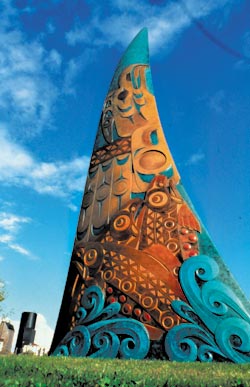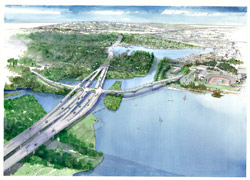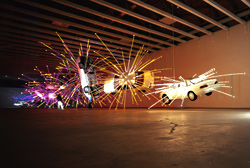It May be a surprise to learn that Seattle Art Museum has plans to include Native American art in its sculpture park project. Or it once did. A SAM press release from September 2004 states: “In addition, the Northwest’s Native American communities are working with SAM to determine exciting collaborative art projects for the future at the Olympic Sculpture Park.”
Sounds promising. In fact, the idea makes perfect sense in a region rich with Native American art and culture, in a city named after Chief Seattle. The park site itself—long before the Denny Regrade—was inhabited by the Duwamish people, who camped in the area every fall and used vast nets to capture migrating ducks.
But while the museum recently trumpeted the acquisition of Richard Serra’s tremendous Wake, and there has been minor controversy around the commission of a Louise Bourgeois fountain, SAM has been silent about Native art. Is it going to happen?
“Well, that’s the question. There’s definitely the desire,” says Barbara Brotherton, SAM’s curator of Native American Art. “A lot of groundwork has to be done prior to announcing anything like that. At this point, I don’t know that we have anything new to report.”
Deciding what to include is part of the challenge. Funding is another big issue. Many of the pieces in the park have been gifts. Who will donate or commission a significant work by a Native artist? Who has one to give?
“It’s definitely a priority for the museum to have a Native American work in the park. It will happen,” adds SAM spokesperson Cara Egan. “I want people to know this is not it—it’ll change. It won’t ever be a stagnant project.”
In the meantime, Brotherton says indigenous plants of medicinal value—Western red cedar, alder, trillium, blue sedge, kinnikinnick—will be incorporated into the initial landscaping, with up to 40 plant labels written first in Lushootseed, the native language of the local Salish tribes, followed by inscriptions in Latin and English. The labels will also explain the plants’ traditional uses.
And ecologist/artist Mark Dion’s 80-foot Seattle Vivarium greenhouse containing a 60-foot nurse log has a painted tile honoring naturalist Sibiyay Bruce Miller, a late Skokomish elder. “His name will be up there with John Muir, Rachel Carson. He kept plant knowledge alive,” says Brotherton. She is also planning “the first comprehensive exhibition of Salish art,” for 2008, after SAM itself reopens. It will be an extensive traveling exhibit with a catalog.
All of which is good, but it sounds like the park will finally open in January without indigenous art. This seems like a missed opportunity to many in the community.
“I think it’s [a case of] the prophets never being honored in their own land,” says Paul Nicholson, co-owner of Pioneer Square’s Legacy Gallery, the city’s oldest dealer of traditional Native American art. “People come from all over the world to see Native American art here. Here they [SAM] want to bring London art, art from Italy—in the end, it appears they’re neglecting what’s right under their noses.”
“I think [people] pigeonhole Native artists as craftspeople—not on par with artists from New York,” says Marvin Oliver, 60, a local sculptor, professor at UW, and adjunct curator of contemporary Native American art for the Burke Museum.
Oliver, who is of Quinault and Isleta Pueblo descent, was once mentioned by Brotherton as a possible contributor to the park. He merges traditional style with modern materials, working in bronze and glass as well as wood. Earlier this year, he installed a 7-ton suspended glass sculpture of a mother whale and pup in Seattle’s Children’s Hospital. In the Central District, his 26-foot bronze whale fin rises from the ground, embossed with Native symbols of salmon and waves. He has experience with public commissions, but not all Native artists do, and that is one of the challenges to selecting the appropriate artist, says Brotherton.
Another question is, should Native art, traditionally created for ceremonies, be placed in a manicured artificial landscape without context? How will it mesh with the art already there? “Native American art is not ‘art for art’s sake’ but ‘art for culture’s sake,'” says the Legacy’s Nicholson.
“in the makah language, there is no word for ‘art.’ The closest word we have translates as ‘making ready for the potlatch,'” says master carver Greg Colfax, pointing out the nuances of the different purposes of Native and non-Native art. Colfax has not heard about the plan, but would like to see it happen.
One point where Brotherton and local artists agree: “There are [Native] artists out there who are every bit as deserving as those that are there in the park right now.
“From the very beginning, we’ve had discussions that the Native people have lived there for a long time and what can be done to acknowledge that,” says Brotherton. “As things evolved, it became a little unclear when we would be able to undertake that.” When Brotherton joined SAM in July 2001, Lisa Corrin was overseeing the sculpture park project. Corrin left in 2005 and was replaced by Michael Darling, who moved to Seattle from Los Angeles this past summer. He is still getting acquainted with the local art scene and history. It sounds like these plans may have gotten lost in the shuffle.
Brotherton has held community forums and “focus groups” with representatives of various tribes to determine what should go in the park, respecting the numerous tribal sensibilities. “This is really a new foray for us, so we’re trying to get it right,” says Brotherton.
Each of the artists interviewed for this article is eager to see Native art in the park.
“As a Native artist, I’d love the opportunity,” says James Madison, 32, whose heritage is a mixture of Tlingit and Snoqualmie/Snohomish. “I’d love to have it—sculpture, whatever it may be—be from this area.” An example of his contemporary style, Split Personality, is currently on view on the Harbor Steps for the West Edge Sculpture Invitational. A member of the Snohomish County arts council, Madison says his mission is to “show that Native Americans are not petrified. The way you do that is put [their] artwork among all the other sculptures. I think [SAM] should have a strong voice in pushing Native American art. Here’s the opportunity of a lifetime.”








